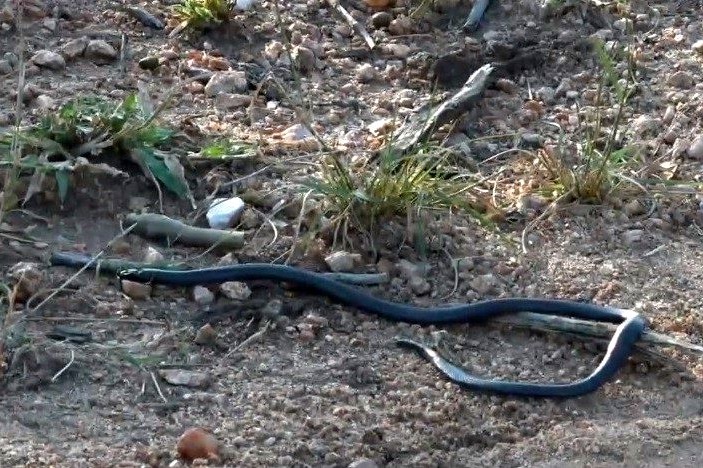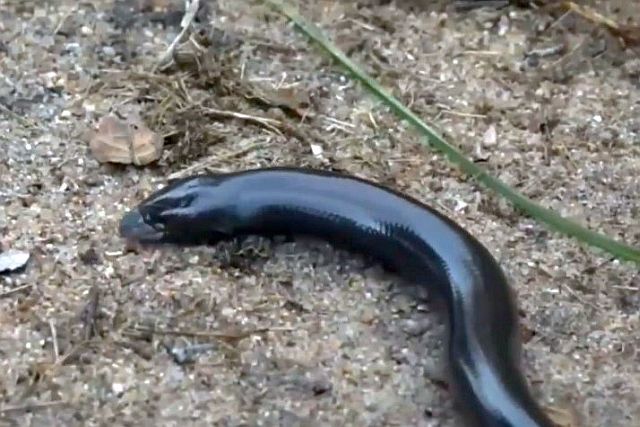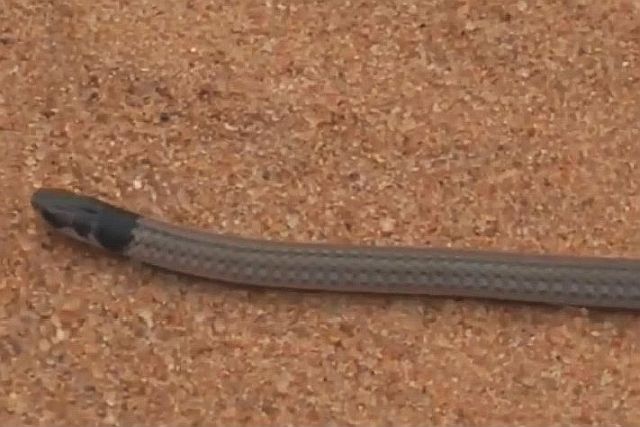Page 5 of 6
Spotted Bush Snake - 40 points
Posted: Sun Feb 24, 2019 6:31 pm
by Dindingwe
Spotted Bush Snake (Philothamnus semivariegatus)
Skukuza Rest Camp
Mozambique Spitting Cobra - 40 points
Posted: Sun Feb 24, 2019 6:35 pm
by Dindingwe
Not 100 % sure, as it is a juvenile, but I think :
Mozambique Spitting Cobra (Naja mossambica)
H3
Bushveld Lizard - 30 Points
Posted: Sun Apr 14, 2019 10:16 am
by Flutterby
Bushveld Lizard Heliobolus lugubris
This lizard has evolved to mimic
Anthia beetles, a remarkable adaptation known as ‘Batesian mimicry’. Anthia beetles spray a noxious acidic pungent fluid when molested. To resemble such a beetle, the juvenile Bushveld lizards are jet black with white markings and are the approximate size of the beetles. Like the beetle they also walk stiffly and jerkily while foraging with arched backs and tails pressed to the substrate. By mimicking these beetles, it is thought that the incidences of the juvenile lizards being preyed upon by predators such as birds, mongooses and snakes are significantly reduced.
When the lizards reach a length of 40 mm, metamorphosis into the uniform brown and grey adult colouration of the lizard begins and is complete when they are 50 mm in length.

© Klipspringer
Resting in the grass along the Matjulu loop
Cape Wolf Snake - 60 Points
Posted: Mon Apr 15, 2019 1:01 pm
by Flutterby
Cape Wolf Snake Lycophidion capense

© Klipspringer
Lower Sabie
Common Rough-scaled Lizard - 40 points
Posted: Mon Apr 15, 2019 1:05 pm
by Flutterby
Common Rough-scaled Lizard Meroles squamulosus

© Klipspringer
Mopani Camp
Giant Legless Skink - 40 points
Posted: Thu Apr 18, 2019 8:16 am
by Flutterby
Giant Legless Skink Acontias plumbeus
The Giant Legless Skink is usually uniform dark brown or black although yellow/brown specimens have been found. It is the largest Legless Skink reaching around 50 cm in extreme cases, but averaging around 30 – 40 cm. Head broad with elongate, steel-grey snout. Eyes small. Like many members of the genus, it retains eyelids.
It burrows in moist leaf litter and eats worms and insect larvae. It occurs from about East London up to northern KwaZulu Natal and then north to Swaziland and the Kruger National Park.

© Klipspringer
S83
Black-Headed Centipede-Eater - 50 points
Posted: Fri Apr 19, 2019 8:45 am
by Flutterby
Black-Headed Centipede-Eater Aparallactus capensis
A small slender snake that averages 30 cm with a maximum length of 40 cm. This common snake is usually found in deserted termite mounds or under logs and rocks where it is very common.
The Black-headed Centipede-eater is a specialist feeder and preys on centipedes – it will seize its prey and then chew along the body until the venom takes effect. The centipede is eaten head first.

© Klipspringer
S100
Peters' Thread Snake (Glossy Worm Snake)- 50 points
Posted: Sat Apr 20, 2019 11:41 am
by Flutterby
Peters' Thread Snake (Glossy Worm Snake) Leptotyphlops scutifrons
Peters’ Thread Snake (
Leptotyphlops scutifrons)
A very small snake that averages around 20 cm in length. The Thread Snakes resemble worms and it can be difficult to distinguish the head from the tail. They are burrowing snakes with a cylindrical body and the eye is minute. They feed on invertebrates, especially termites and their eggs. The Thread Snakes spend most of their lives underground but may come to the surface after heavy rains. They are sometimes found under rocks and logs and old termite mounds.

© Klipspringer
Tamboti Camp
Snouted Night Adder Causus defilippii - 50 points
Posted: Sun May 05, 2019 8:45 am
by Klipspringer
Snouted Night Adder Causus defilippii
The Snouted Night Adder is so-called because it is the only night adder species with a sharply upturned snout, but it belies its common name, hunting both during the day and night and is fond of basking in the sun. It feeds almost exclusively on frogs, particularly toads.
A small, stout viper, averaging 35 cm, with a maximum length of 43 cm. Patterning is usually gray or brown with a series of broad, alternating light and dark brown rhombic blotches along the dorsum of the back. It has a dark V-shaped marking on the back of the head and dark postocular stripes. Night adders have smooth scales that feel velvety to the touch, and round pupils, unlike typical vipers, which possess keeled scales and vertically elliptical pupils.

- S52.jpg (263.65 KiB) Viewed 1198 times
Western Stripe-Bellied Sand Snake - 50 points
Posted: Sun May 05, 2019 12:36 pm
by Mel
Western Stripe-Bellied Sand Snake Psammophis subtaeniatus
A striped sand snake with slender body, large eyes and round pupils. It has slender pointed head with blotches and distinct dorsal stripes down the body, with a lemon-yellow belly, bordered by a black hairline in either side. The outer portions of the belly are pure white. It has a grey-olive back with a broad black-edged stripe down the back, bordered by a narrow cream to yellow stripe on either side; then there is a dark lateral stripe with a black line on the lower edge. The head has pale edged markings that form transverse bars. It grows to an average length of 1 meter and a maximum length of 1.4 meters.
Orpen Rest Camp

- ss.jpg (88.92 KiB) Viewed 1118 times
© Richprins
H1-8